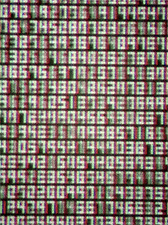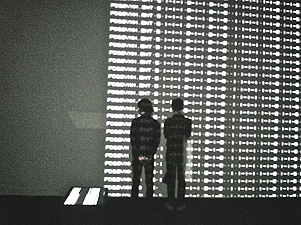Black and White and Read All Over the Armory

“Hey, it’s like being inside a TV, Mama,” my son said. Ryoji Ikeda’s spectacular installation at the Park Avenue Armory did remind some of us of the horizontal and vertical controls that cured the errant scan lines of yesteryear.
Upon entering the massive yet elegant Grand Marnier lit 19th century building for the opening reception, we saw the very shy, somewhat diminutive artist in sunglasses—How could this work of his be so colossal, extroverted, and commandingly powerful?

![]()

Ikeda’s the transfinite is kind of like God for atheists. An expression of mathematical data describing the infinite, it is immediate—overwhelming yet comforting. Projections of parallel black and white lines and grids of numbers are perpendicular to the floor—a clean white beach—where people walk shoeless or recline to confer, dance and contemplate. Occasional plinths dot the landscape, each topped with displays of data, white type rushing against black ground, mutating dynamically like a river you want to arrest with your touch. For a textile designer, it is seeing patchworks of stripes and extreme close-ups of plaids rushing in contrasts.
The transfinite is also the voice of mathematical output, accompanied by its own mewing resonant sound waves, like chanting mantras. The Armory’s Drill Hall is transformed by its immersive starkness yet warmth, and we were filled with meditative awe and the experience of communion.